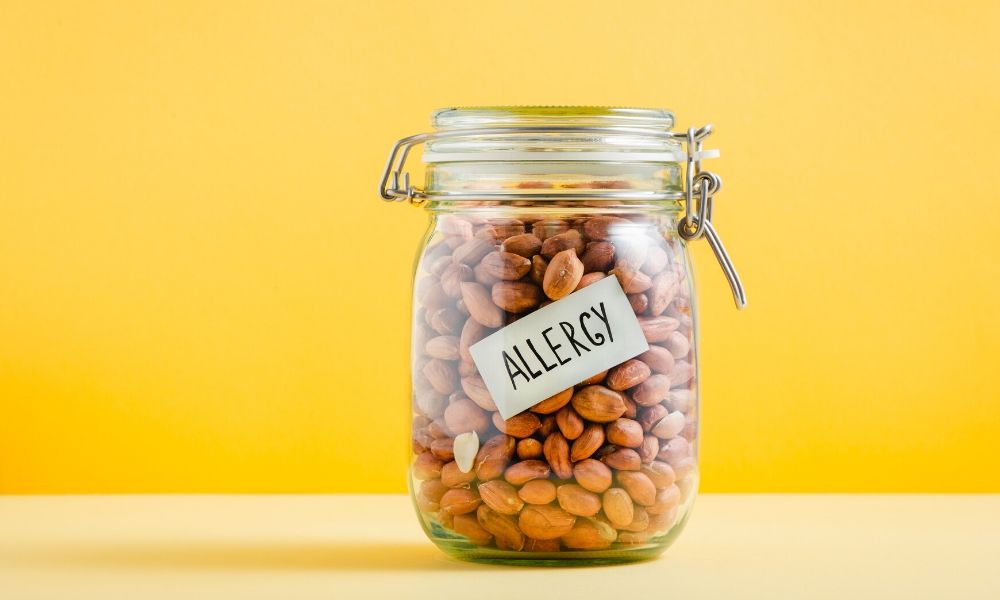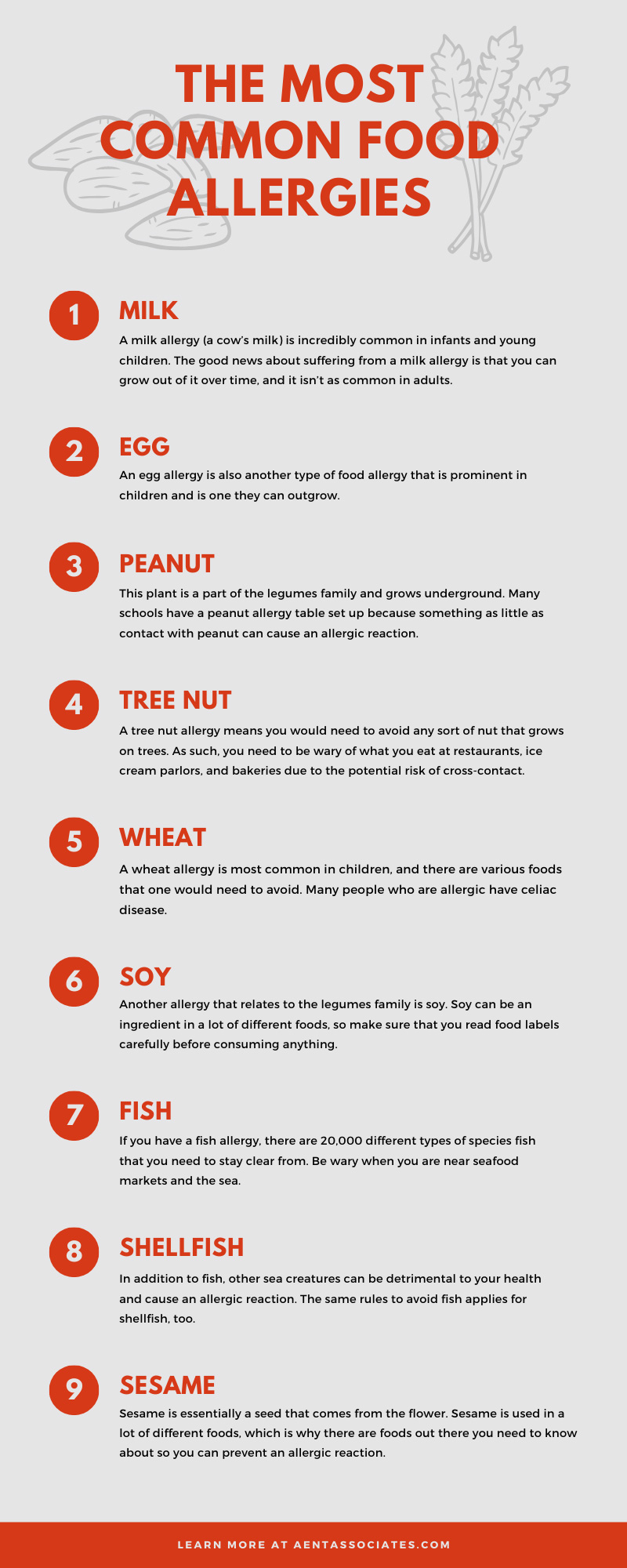
There are various types of elements out there that can cause an allergic reaction such as medication, pollen, mold, dust, pets, insects, latex, and food. A food allergy is one of the hardest kinds of allergies to live with because it requires a lifestyle change. There are also many different types of food you might be allergic to. Learn all about the most common food allergies below.
Signs of a Food Allergy
Before we get into the most common food allergies, it’s important to know the symptoms. There might be some reactions caused by certain foods, whether you consume or come into contact with them. These symptoms may include:
- Itching or swelling in your mouth
- Hives
- Vomiting
- Diarrhea
- Abdominal cramps and pain
- Eczema
- A drop in blood pressure
- Issues breathing
- Tightening of the throat
If you notice that you are suffering from any of the symptoms above frequently, it’s critical that you go to a local allergy clinic, such as Allergy & ENT Associates in Houston, for a test so you can figure out what is causing these allergic reactions.
Types of Food Allergies
Milk
A milk allergy (a cow’s milk) is incredibly common in infants and young children. The good news about suffering from a milk allergy is that you can grow out of it over time, and it isn’t as common in adults. If someone does have a milk food allergy, they must avoid:
- Milk
- Cheese
- Butter/Margarine
- Ice Cream
- Yogurt
- Cream
Some good alternatives for someone who has a milk allergy include:
- Soy milk
- Almond milk
- Coconut milk
- Oat milk
- Rice milk
Egg
Another common type of food allergy that we can get from animals is eggs. An egg allergy is also another type of food allergy that is prominent in children and is one they can outgrow. Eggs are incredibly nutritious; however, an allergy means that you need to avoid them completely. Egg is also an ingredient in a ton of different foods. Some foods you need to look out for include:
- Egg (white, yolk, solids, powdered, dried)
- Mayonnaise
- Eggnog
- Albumin
- Meringue
- Lysozyme
There can also be eggs in the following:
- Pasta
- Ice cream
- Marshmallows
- Nougat
- Pretzels
Peanut
Being allergic to peanuts is another very common allergy people suffer from. This plant is a part of the legumes family and grows underground. Many schools have a peanut allergy table set up because something as little as contact with peanut can cause an allergic reaction. If you are someone who has a family history of peanut allergies, many medical professionals believe the allergy will continue to pass down from one generation to the next. Some foods that have peanuts in them include:
- Peanut butter
- Mixed and artificial nuts
- Lupin
- Nut meat
Some surprising foods might have peanuts in them as well, such as:
- Egg rolls
- Ice creams
- African- and Asian-based foods
- Nut butter
- Pancakes
- Pet food
- Sweets
With a peanut allergy, you also need to be conscious of fried foods. For example, many places will use peanut oil to cook french fries, so be sure to ask before you place your order.
Tree Nut
Although peanuts fall under the category, it’s another type of nut that people can have an allergic reaction. A tree nut allergy means you would need to avoid any sort of nut that grows on trees. As such, you need to be wary of what you eat at restaurants, ice cream parlors, and bakeries due to the potential risk of cross-contact. Many foods contain tree nuts, including:
- Almonds
- Butternut
- Cashew
- Chestnut
- Coconut
- Macadamia
- Nut milk
- Pecan
- Pistachio
- Walnut
- Pesto
A good rule of thumb to follow is if there is a nut in the name of the food, avoid it if you have a tree nut allergy.
Wheat
A wheat allergy is most common in children, and there are various foods that one would need to avoid. Many people who are allergic have celiac disease. This means that your diet has to consist of gluten-free alternatives. Common foods that contain wheat are:
- Bread
- Pasta
- Flour
- Beer
- Hot dogs
- Candy
- Cereals
- Crackers
- Marinara sauce
- Soups
- Potato chips
Soy
Another allergy that relates to the legumes family is soy. Soy can be an ingredient in a lot of different foods, so make sure that you read food labels carefully before consuming anything. Some foods that have soy include:
- Soybean
- Soy sauce
- Tofu
- Miso
- Edamame
- Cookies
- Cereals
- Soaps
- Sauces
- Crackers
Fish
Fish is an excellent source of protein; unfortunately, however, there are some people who can’t eat it due to an allergy. If you have a fish allergy, there are 20,000 different types of species fish that you need to stay clear from. Be wary when you are near seafood markets and the sea. If your allergy is really severe, you might not even be able to touch fish either. Some of the main types of fish you need to stay away from are:
- Anchovies
- Bass
- Catfish
- Flounder
- Salmon
- Tuna
- Coad
- Swordfish
Shellfish
In addition to fish, other sea creatures can be detrimental to your health and cause an allergic reaction. The same rules to avoid fish applies for shellfish, too. Typically, you can easily identify a shellfish due to its shell appearance, but here is a list of foods you should avoid that might contain any:
- Crab
- Crawfish
- Lobster
- Shrimp
- Barnacle
- Prawns
Some other foods professional might recommend you do not consume include:
- Scallops
- Snails
- Octopus
- Oysters
- Clams
- Calamari
Sesame
Sesame is essentially a seed that comes from the flower. Sesame is used in a lot of different foods, which is why there are foods out there you need to know about so you can prevent an allergic reaction. Many of the foods and spices that include sesame as an ingredient already have it in the name; however, the following are some that don’t:
- Gingelly
- Sim sim
- Til
- Halvah
- Tahini
- Tahina
- Tehina
- Hummus
- Falafel
- Chips
- Crackers
- Cereals
- Bread
- Sushi
- Soups
- Flavored rice
Other Food Allergies
While we listed the majority of the allergies that people suffer from above, there are more. Some other food allergies that are not as common, but can affect some people, are:
- Meat
- Gelatin
- Seeds
- Spice
- Fruits and Vegetables
- Corn




